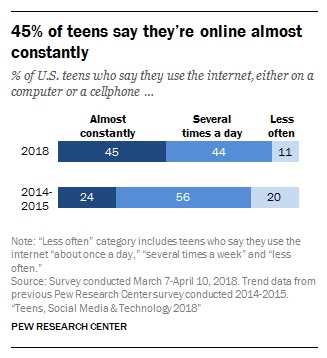Parents of teens probably knew this already, but the Pew Research Center just confirmed it for everybody: YouTube, Instagram and Snapchat are US 13-17 year-olds’ top social media picks now – at 85%, 72% and 69%, respectively. That’s according to Pew’s just-released “Teens, Social Media & Technology 2018.” [The percentages add up to more than 100% because, as is well known, teens use multiple social media apps and services, often simultaneously.] Filling out the top 7 were Facebook in the 4th position (at 51%), followed by Twitter (32%), Tumblr (9%) and Reddit (7%).
 Snapchat is No. 1, though, for frequency of use. When Pew asked its respondents what social media they use most often, 35% said Snapchat, as opposed to 32% YouTube and 15% Instagram. That might have something to do with the fact that teens use Snapchat as much for chatting (which is very much like texting, obviously a high-frequency tech activity) as anything else.
Snapchat is No. 1, though, for frequency of use. When Pew asked its respondents what social media they use most often, 35% said Snapchat, as opposed to 32% YouTube and 15% Instagram. That might have something to do with the fact that teens use Snapchat as much for chatting (which is very much like texting, obviously a high-frequency tech activity) as anything else.
Snapchat streaks could be a bit of a factor too. They’re a kind of game that’s unique to Snapchat whereby friends will send each other a snap every day and see how long they can keep it going (streaks can be entertaining, transactional or stressful, depending on the people involved and how they’re feeling that day; for more, see BusinessInsider.com). Those two factors are just speculation on my part; the important takeaway is that – because each social media service has unique features and each user has their own uses and intentions (which can vary by time of day, even!), it’s hard to generalize about its use, and solid research like this is the best possible way to get the big picture.
Incidentally, a Snap spokesperson just told me that 13-17 year-olds aren’t Snapchat’s largest age group. They actually come in at third place in the app at 20% of its users, after 18-24 year-olds (37%) and 25-34 year-olds (27%). People 35+ are the app’s smallest cohort at 16%.
Some more interesting highlights from this report:
- Smartphones: “95% of teens [97% of girls, 93% of boys] now report they have a smartphone or access to one,” up 22% over Pew’s last survey in 2014-’15. Income is hardly a factor: 93% of 13-14 YOs in <$30k/year households and 93% in households with incomes of $30k-74,999 “have or have access at home to a smartphone,” while 97% of teens in households of $75,000+ do.
- Computers: 88% of teens have or have access to a laptop or desktop at home.
- Use levels: “45%…say they are online on a near-constant basis,” up from 24% in the last survey.
- Gaming’s huge: Not surprisingly, based on past Pew research, 90% of US teens – 97% of boys, 83% of girls – play digital games somehow (computer, console or phone), and 84% “have access to a game console at home”; 85% of teens in households earning $30,000/year a year have a game console at home, up from 67% in 2014-2015.
- Different platforms: Teen use of Facebook has dropped 20% since Pew’s last report, where, at 71%, it was No. 1 among US teens. The % hasn’t changed much at Twitter and Tumblr. Pew didn’t even ask teens about YouTube in the last survey (possibly because they and society in general didn’t see it as social media). Reddit wasn’t in the last survey either.
- Use diversifying: No single platform dominates teens’ social media use. Facebook used to.
- Income: A big change over 10 years ago was that “lower-income teens are more likely to gravitate toward Facebook.”
- Gender: Girls are more likely than boys to say they use Snapchat most (42% vs. 29%), and boys YouTube more (39% vs. 25%).
- Race/ethnicity: Snapchat is used more often by white teens (41%) than Hispanic (29%) or black (23%) teens; “black teens are more likely than whites to identify Facebook as their most used site (26% vs. 7%).”
- Teens’ views on impacts: Pew reports “no clear consensus among teens about the effect that social media has on the lives of young people today”; the largest percentage (45%) said the effect has been “neither positive nor negative,” 31% says the effect is mostly positive, 24% mostly negative.
Pew gave the respondents themselves a chance to describe how social media affected them positively or negatively. Please check out the report for the responses that the study’s authors chose to highlight.
Related links
- Snap CEO Evan Spiegel’s Interview interview with Kara Swisher on stage at the just-ended Code Conference
- The Code Conference video of Facebook COO Sheryl Sandberg and CTO Mike Schroepfer’s on-stage interview
- Coverage of the Pew report at Bloomberg, the Chicago Tribune and the Washington Post

Leave a Reply